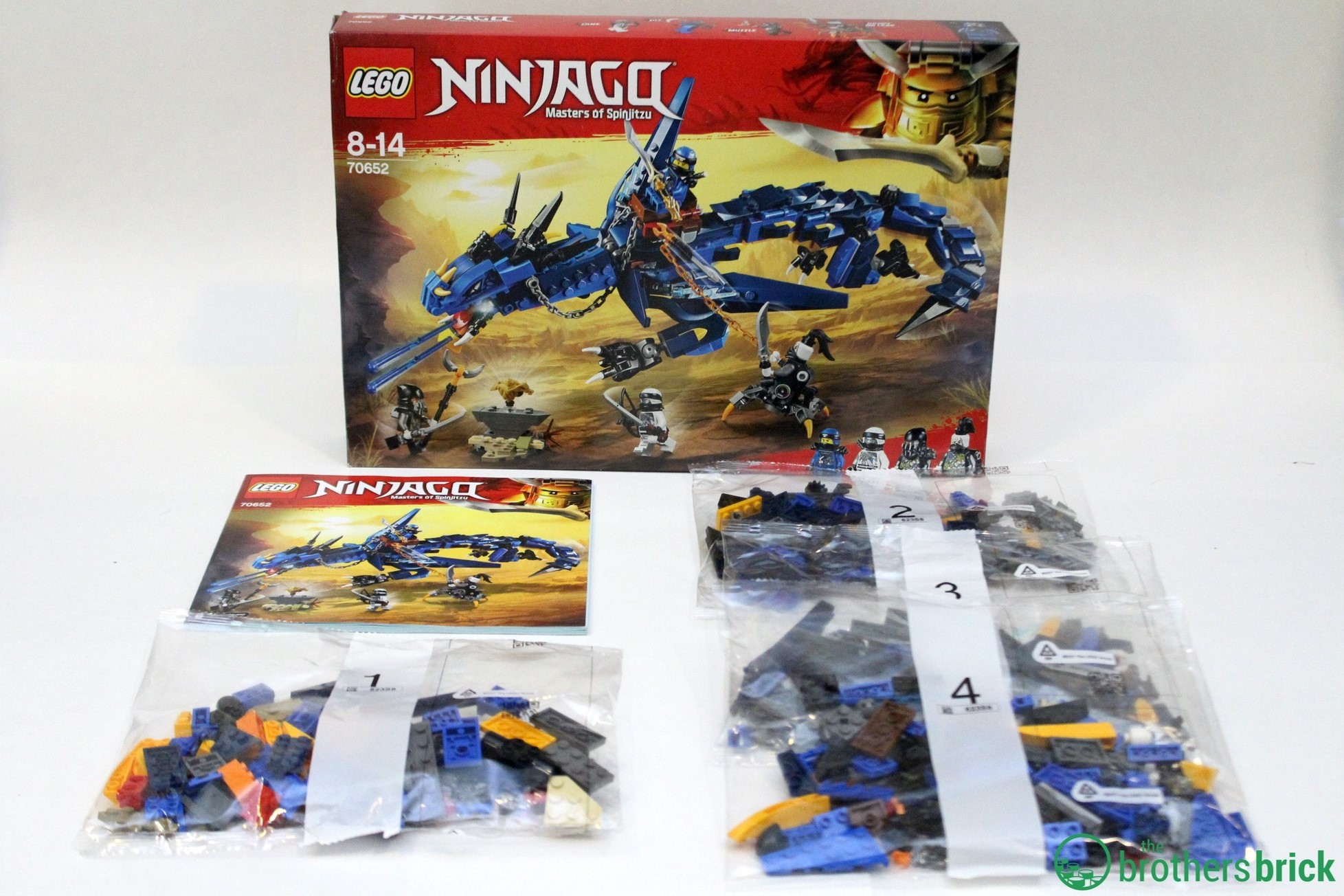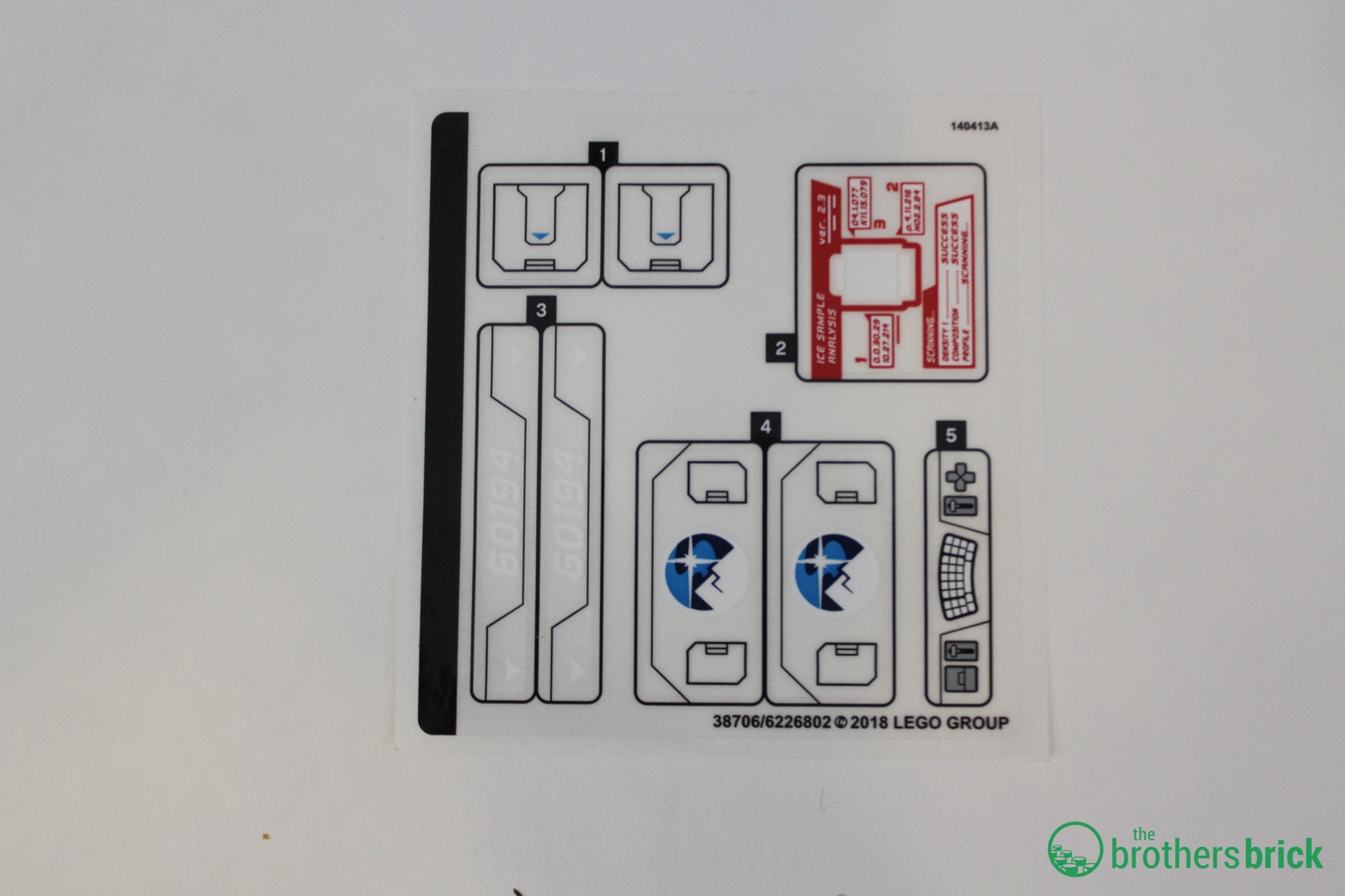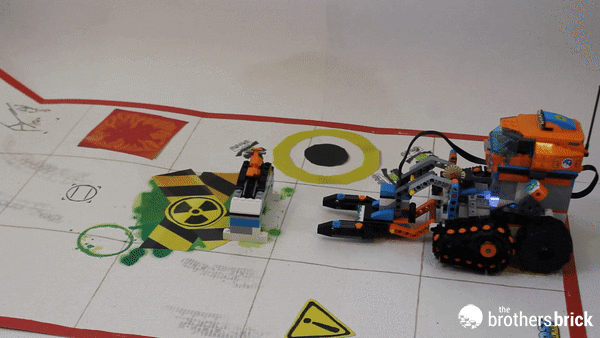The latest wave of LEGO sets includes several sets designed to work with LEGO Boost — the first sets to extend the 17101 BOOST Creative Toolbox into a true system. Not only are the LEGO City 60194 Arctic Scout Truck and LEGO Ninjago 70652 Stormbringer sets compatible with Boost, they are fusions with the robotics system.
LEGO City 60194 Arctic Scout Truck has 322 pieces and 3 minifigures at $59.99 USD, while LEGO Ninjago 70652 Stormbringer has 493 pieces and 4 minifigures $39.99 USD. Both sets are available now as part of the summer 2018 wave of new LEGO sets, along with Boost released last year.
The boxes, instructions, and sticker sheet
Naturally, the star of this review is BOOST. But because we have already written a review of the 10171 BOOST Creative Toolbox, we’ll mostly focus on the other two and their compatibility with the BOOST system. For those individual sets, we have a brief synopsis of our findings. The LEGO Ninjago 70652 Stormbringer box contains four inner bags and a single instruction manual. It does not include stickers; instead, the few decorated elements are printed.
The box for the LEGO City 60194 Arctic Scout Truck also contains four inner bags, but it has two instruction manuals, as well as a small sticker sheet.
The sticker sheet depicts a few decorative elements in addition to a “computer screen” that displays numerical feedback involving an ice core sample analysis.
The builds
This was certainly a review of multiple phases, and the first phase was building and getting acquainted with the original models. Although we already have an individual review for BOOST, I had to become familiar with the system myself.
BOOST is actually pretty fun to play with on its own, although I had issues getting started. The set is intended to be geared toward the programming experience for younger kids. Instead of having them physically build the robot via printed instructions and then turn to a tablet or computer for programming (like the LEGO Mindstorms 31313 EV3), the designers chose to have them build in stages and program as they go. The best way to do that was to eliminate the instruction booklet and make it part of the app. I discovered my iPad 2 and iPad Mini were both too old and incompatible. When I finally got it onto my laptop, there were a few glitches that warranted restarting the app. This is probably because it is better designed for a touch-screen tablet. Fortunately though, it remembers exactly where you left off.
Moving on to the other models, the larger of the two, the Stormbringer, is a neat build. The dragon is posable and has a nice shape and feel to it. Also, the shooters in the mouth are a fun touch, although it makes the neck oddly long. The minifigs look pretty cool with all-new body parts and weapons (see their section below).
Other than the minifigures discussed below, there are a few parts that are new or unique. This is the first time that both the 6×4 Triple Inverted Curved Wedge and Horn are featured in Bright Light Orange. The Dark Grey Inverted 1×1 Bracket and Reddish Brown 2×2 Pentagon with Tab have only been seen in a handful of other sets. Also, the Pearl Gold Dragon Armor and Dragon Head Sword Hilt have both only just recently been released with this new wave of Ninjago.
As mentioned before, there are no stickers in this set, therefore the dragon eyes are newly printed elements. Also, as an aside, the pile of extra parts after finishing the regular set is pretty impressive. It contains mostly extra minifig accessories.
The Arctic Scout Truck isn’t the most memorable set you’ll ever build. It’s pretty standard for a lot of City sets, with the basic vehicle body design. One of the disappointing parts of this model is that you would think the front treads would have some sort of nifty mobility. As in, maybe suspension or turning capability. But they are fixed, which is a bit of a negative in the play department. On the other hand, one of the better parts is how satisfying it is to perfectly fit the treaded-motorcycle/snowmobile into its slot in the truck bed.
The Scout does have some new/er and unique parts, though. Aside from the figs and their accessories, the Flat Silver Motorcycle/Snowmobile Chassis is brand new with the latest Arctic wave. The Dark Blue Double Inverted Slope with 4×4 Cutout and Orange 4×1 Slope are also both newer and uncommon colors for their molds. Finally, the Dark Grey 1×2 Tile with Printed Map and Trans Light-Blue 1×1 Round Brick with Printed Dragonfly are both new to the wave as well.
The finished models
While the combination builds have elements that look very similar to the original sets, you don’t just take the originals and put motors on them. The designers tried to blend the sets together as much as possible, and therefore BOOST pieces are often inserted in place of a similar counterpart. Entire areas are changed to incorporate not only the BOOST system, but also the Technic-y BOOST style and decorative elements. This means that pretty much each entire set has to be broken down.
After taking apart the original models and moving on to the BOOST combos, it becomes apparent that there is one major challenge: finding the parts. It’s easy to take for granted that sets often come in multiple bags and the instructions indicate to open them one at a time. But after the original models are built, it becomes a lot more time consuming. You’ll triple or quadruple in pieces, and the best way to proceed is to sort the parts before continuing.
Starting out, it seemed like the Stormbringer would be the least favorite of the two combos. At first glance, it looks like they just pulled the head and tail off the body, and slapped the “move hub” in the middle. The long, dark grey bars connecting the legs look a little clunky too. But it was actually way more fun than it appeared. The final model is a fair amount bigger than the original Stormbringer, enhancing the build portion of the experience. Taking breaks to program and interact makes it interesting because you begin to develop a bit of a relationship with the dragon as BOOST brings it to life and gives it personality. Along the way you also get to interact with the minifigs, as well as other buildable characters. The one unfortunate thing is that he can’t turn very well.
The Scout, on the other hand, somewhat does the opposite. It’s still a fun build with a nice design overhaul, but it doesn’t quite live up to expectations of superior enhancement. That’s probably mostly due to the programming part, but we’ll get to that later. While Stormbringer looks a lot like the original, Scout loses everything but the cab. The model gets bigger, but not by as much, and more time is spent building other elements to interact with. Personally I was expecting the rig to be a little more detailed and complex. Still, it’s a step up from the base set. The ability to turn easily is a drastic improvement.
An interesting aspect to both models is how many pieces are left behind. After each build is completed, there are pretty massive piles of parts that don’t get used. This is a surprise on the Scout because it feels like so many parts from both sets are used to make the large collection of accompanying mini-builds. It seems like the designers could have kept going because they are good parts. But we’re not complaining! It certainly isn’t a bad thing to have a whole set worth of parts left over to make your own add-ons.
The app and coding
The in-app instructions are just like your regular paper instructions, but digital. You press a button to move on to the next step, just as you would turn a page in a booklet. At very least it’s a major paper-saver. Probably hundreds of thousands of sheets of ink-filled paper are saved by going this route.
As mentioned before, you take breaks at reasonable stopping points (i.e. body parts for Stormbringer) to program your creation. Because this is intended for children, the user unlocks achievements and more programming blocks with every section completion.
Dragging and dropping blocks for programming is pretty simple and straightforward. It’s fun to be able to build a program quickly and watch it work. In that regard, these models are loads of fun. On the other hand, the attempt at simplicity through the lack of descriptors leaves us confused. There are several instances in both models where the program block images are highly ambiguous. When the program follow-through doesn’t do much, it leaves us scratching our heads. But that being said, we still enjoyed ourselves!
As mentioned before, Scout has a few major changes in the BOOST-compatible model. In the new build the little truck has some impressive turning capabilities. It also gained a forklift-esque liftarm, and became pretty well adapted for picking things up.
Actually, the primary function of the model is to pick things up and move them. Interestingly, the only time the in-app instructions call for interacting with one of the figures is when Scout is programmed to pick up and move a basket containing the dog. Of course, it’s up to the builder’s imagination to expand on the minifigure interactions.
As to be somewhat expected, the Scout is not a fine-steering dead-eye when it comes to picking things up. The color sensor is not capable of detecting whether or not the vehicle is perfectly on target. Therefore, there’s a lot of trial and error involved in aiming Scout appropriately so that it doesn’t knock over or miss the object. Sometimes even when it seems right on, it misses.
You may notice that Scout has many more mini-builds to interact with than the bike-carrier or the dog basket. But unfortunately the primary instructions don’t make a lot of sense in terms of the Scout’s ability to interact with them. For example, the following program calls for placing the wind sock in the corner of the playmat, as if it has a purpose there. Then a mysterious snowflake block is attached to the program. Upon starting the sequence, a window with only a picture appears to prompt the user to shake Scout and move its lift-arm up and down. After several shakes with crackling sounds, fanfare indicate some accomplishment has been achieved and the program ends. Odd…
Stormbringer is a little more impressive in terms of interactive-ness. For example, holding him by the tail makes him squirm and produce fart noises (through your device’s speaker). The internal sensors of the move hub are sensitive enough that you can program the dragon to react to a gentle touch. In the following GIF, he snores softly until he is stroked. Then he wakes up, moves, and purrs in response. Notice that it’s not the color/motion senor in the saddle picking up the hand movement.
The color sensor allows you to program Stormbringer to recognize Jay. When his companion is in the saddle, the dragon gets excited. Then when Zane or another minifigure is in the saddle, he moves and swings his head until they fall out. Alternatively, you can program him to accept Zane and only kick out a bad guy wearing black.
One of the impressive features is the way the designers worked in Stormbringer’s ability to shoot. The movement pattern of his head gives him life and acts as a sly mechanism for the launch. It take a certain degree of rotation for the shooters to hit the yellow beam and be triggered.
The programming part for Stormbringer still has its confusing icons, but for the most part, the images make sense, especially once the program starts.
The minifigures
There are three minifigs that come with the Arctic Scout Truck, all sporting gear unique to the new wave of Arctic sets. Other than the torsos, which are great in their own regard, the best elements are the head gear. The female minifig sports a new Dark Azure Beanie, while one of the males has a pretty awesome Tan and Red Ushanka Hat.
The second male, who operates the snow bike and ice corer, dons a cool new Dark Azure Motorcycle Helmet.
For the animal lovers, this set comes with a Husky Dog and a Polar Bear. The latter has only been seen in two other sets, both released in 2014.
Stormbringer comes with four Ninjago minifigures, including Zane, Jay, Daddy No Legs and Muzzle. Our heroes wear outfits unique to the latest wave of Ninjago sets. Both minifigs are dual-faced, with Zane’s head being particularly unique. Attached to the dragon-head hilt previously mentioned, Jay carries a sweet new marbled sword.
All of the minifigs are part of the new season of the Ninjago show, subtitled Hunted. In it we are introduced to a couple new bad guys: Daddy No Legs and Muzzle. These figs are currently only in this set. They are particularly evil-looking characters, with cool new outfits as well, especially Muzzle’s muzzle-like headgear/armor.. None of the parts composing Daddy No Legs’ mechanical bottom half are very new, but the use of the Black Backpack with Horizontal Pin Holes is great. Unlike Zane and Jay, their faces are not dual-sided.
In addition, there is also a brand new Multipack of 10 Bladed Weapons that have only been seen in one other set so far.
Conclusions and recommendations
Combining all three of these sets has been quite time-consuming, but truly a lot of fun. Any child is likely to be impressed by every one, and I’d discourage adult fans from ignoring BOOST for its simplicity. These pairings demonstrate to children and adults alike that any set can be brought to life, and we’re excited to see what sets will come next and provide future inspiration.
In terms of individual sets, I would say LEGO BOOST 10171 Creative Toolbox is a terrific one to have in any collection. That’s especially true for those who are interested in programming but nervous about getting started with something like EV3. It may have its quirks as far as the block icons not being clear descriptors, but the parts alone give it a great range of possibilities.
LEGO Ninjago 70652 Stormbringer is also a really fun set. I would suggest it especially as something to pair with BOOST. In addition, as a standalone set it has nice parts and good value at $0.08 per piece (based on the $0.10 average standard). On the flip-side, LEGO City 60194 Arctic Scout Truck is a terrible value at nearly $0.19 per piece. This set costs more for fewer pieces, with no significant reasons why. As far as its compatibility goes, Scout was fun but not as interactive. The purpose of some of the suggested programs were confusing, without clear instructions. Therefore, this would definitely not be my first recommendation.
- LEGO 17101 BOOST Creative Toolbox has 843 pieces and is available from LEGO Shop for $159.99 USD. It’s also available at Amazon, Bricklink, and eBay.
- LEGO City 60194 Arctic Scout Truck has 322 pieces and 3 minifigures, and is available from LEGO Shop for $59.99 USD. You can also find it on Amazon, Bricklink, and eBay.
- LEGO Ninjago 70652 Stormbringer has 493 pieces and 4 minifigures, and was just released on August 1st. It’s available from LEGO Shop for $39.99 USD, as well as Amazon, Bricklink, and eBay.
The LEGO Group sent The Brothers Brick copies of these sets for review. Providing TBB with products for review guarantees neither coverage nor positive reviews.




















































































